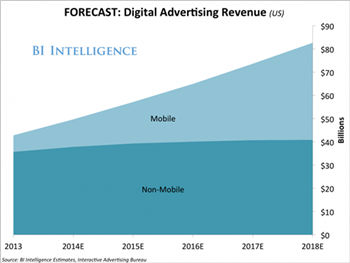How to create effective mobile advertising?
According to a Cisco report, before the end of this year, mobile ad spending will surpass desktop ad spending. With the ever-increasing number of mobile users, mobile advertising is becoming a powerful marketing tool. Which ads will work best on mobile? What conditions they should meet?
We suggest how to make the best use of mobile ads to bring with them the best promotional results.
Digital advertising is still overwhelmingly associated with traditional desktop advertising. However, nowadays a huge part of internet traffic is generated by mobile devices. The vast majority of web users are so called “mobile users”. “Mobile first” users, who reach for the phone first to use the Internet.
Ads optimized for mobile devices, i.e. ads using rich media and native ads. It is also improving mobile targeting, which is very easy in web browsers thanks to cookies, while it doesn’t yet work so well on mobile devices. At the same time, mobile browsers or apps are not yet equipped with ad-blocking software, present on almost every computer.
So this is the perfect time to take care of the effectiveness of mobile ads and implement them into your marketing strategy.
According to the Business Insider report, the most effective and widely used mobile ad formats are display, video, social media and search engine ads. It turns out that display and video ads are gaining popularity the fastest, due to their similarity to desktop advertising – most advertisers choose this type of advertising. Search engine and social media ads are, on the other hand, the most profitable mobile ads in the US. Search engine ads are particularly profitable, due to the customization of search results based on user location.
Also, in-app ads perform much better than those on mobile sites. The global CTR for ads in apps is 0.56%, while on mobile sites it is 0.23%.
In order to make mobile advertising as user-friendly and effective as possible, it is worth following a few rules:
1. Advertising tailored to mobile.
Just as a website that is not adapted to mobile devices is annoying, so too will a mismatched ad be annoying. Content displayed on desktops is different from that displayed on mobile devices, whether it is text, images or ads. Being tied to banner ads can bring poor results, as such advertising is usually unreadable, entailing a lack of engagement on the part of the audience and raising the number of uninformed, accidental clicks. They also take up a relatively large amount of space on a small mobile screen, discouraging users from the entire site or app.
Instead of them, you should consider ads better adapted to small screens. These can be video ads or ads that take up the entire screen, serving as an interlude, for example. When moving from one app function to another. However, it is not worth overusing them, because they also easily cause discouragement to users – the fewer ads, the better results they can bring.
2. Advertising tailored to user activity.
It is worthwhile to tailor ads to the type of activity users are doing, when they most often come across an ad. More user engagement, and therefore more revenue, can be achieved when ads are displayed while users are using their smartphones as part of their leisure time – when users are browsing social apps or playing games. Then their attention is not strictly focused on one activity and it’s easier to get their attention with an ad.
The opposite situation is when the user is reading a longer article or looking for specific information. Then most often he will ignore the ad. Therefore, it is worth adjusting the ad not only to the type of accompanying content, but also to the users’ leisure time.
Ads displayed in the morning (8:00-9:00 am), afternoon (5:00-7:00 pm) and evening (after 9:00 pm) are most effective.
